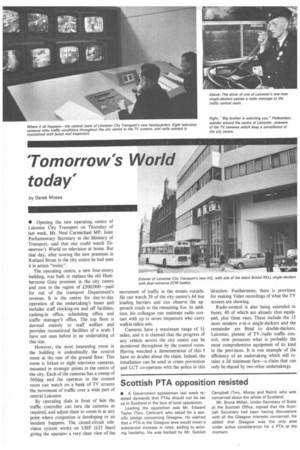Tomorrow's World today'
Page 32

If you've noticed an error in this article please click here to report it so we can fix it.
by Derek Moses
• Opening the new operating centre of Leicester City Transport on Thursday of last week, Mr. Neal Carmichael MP, Joint Parliamentary Secretary to the Ministry of Transport, said that one could watch Tomorrow's World on television at home. But that day, after touring the new premises in Rutland Street in the city centre he had seen it in action "today".
The operating centre, a new four-storey building, was built to replace the old Humberstone Gate premises in the city centre and cost in the region of /300,000—paid for out of the transport Department's revenue. It is the centre for day-to-day operation of the undertaking's buses and includes staff clocking-on and off facilities, cashing-in office, scheduling office and traffic manager's office. The top floor is devoted entirely to staff welfare and provides recreational facilities of a scale I have not seen before in an undertaking of this size.
However, the most interesting room in the building is undoubtedly the control room at the rear of the ground floor. This room is linked to eight television cameras, mounted in strategic points in the centre of the city. Each of the cameras has a sweep of 360deg and the operator in the control room can watch on a bank of TV screens the movement of traffic over a wide part of central Leicester.
By operating dials in front of him the traffic controller can turn the cameras as required, and adjust them to zoom-in at any point where congestion is developing or an incident happens. The closed-circuit television system works on UHF (625 lines) giving the operator a very clear view of the movement of traffic in the streets outside. He can watch 39 of the city centre's 44 bus loading barriers and can observe the approach roads to the remaining five. In addition, his colleague can maintain radio contact with up to seven inspectors who carry walkie-talkie sets.
Cameras have a maximum range of 1+ miles, and it is claimed that the progress of any vehicle across the city centre can be monitored throughout by the control room. Having watched a demonstration of this I have no doubts about the claim. Indeed, the installation can be used in crime prevention and LCT co-operates with the police in this direction. Furthermore, there is provision for making Video recordings of what the TV screens are showing.
Radio-control is also being extended to buses, 40 of which are already thus equipped, plus three vans. These include the 13 most modern o-m-o single-deckers and the remainder are fitted to double-deckers. Leicester, pioneer of TV /radio traffic control, now possesses what is probably the most comprehensive equipment of its kind in the provinces. It is one example of the efficiency of an undertaking which still retains a 2d minimum fare—a claim that can only be shared by two other undertakings.










































































































